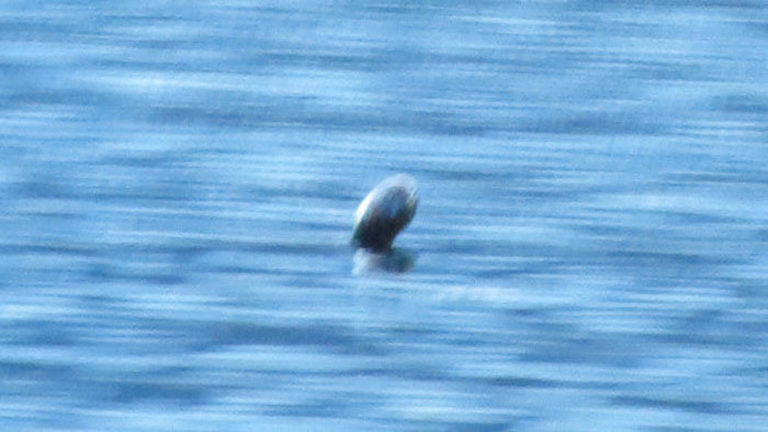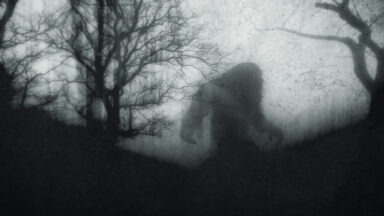3 New Sightings Confirm Ogopogo Lake Monster in British Columbia

Canada’s legendary lake monster Ogopogo was allegedly spotted last month in British Columbia’s Okanagan Lake. Video footage appears to show a large creature breaching the water’s surface, while a still image purports to show the creature’s head.
Like most cryptozoological footage, the video captured by two local men, and later published by local and international news sources, is shaky and difficult to make out — that’s why we’re taking this claim with a grain of salt. But looking at the footage, there are certainly some interesting anomalies.
According to witnesses David and Keith Halbauer, a serpentine creature estimated to be about 40-feet long was spotted off the water’s edge near Bear Creek Provincial Park in Kelowna, BC. In an interview posted on Canadian broadcast website GlobalNews, the brothers claimed to have noticed the creature while camping by the shore.

Skeptics have written off the men’s sighting as simply a rogue wave, but the Halbauer brothers say they know what they saw.
“When you’re sitting on the beach on a sunny day, you don’t expect to see a dinosaur coming out of the water,” said David Halbauer.
Shortly after spotting the creature in the water, the brothers said they noticed a large wake wash ashore from the animal’s breach. Convinced they witnessed Ogopogo, the two shared their story with locals, including the area’s foremost expert on the cryptid, legend hunter Bill Steciuk.
Steciuk has created an entire website devoted to the documentation of Ogopogo sightings, firsthand testimony, and lore surrounding the creature’s history.
The legend of the Canadian lake creature has circulated for centuries, dating as far back as the 1700s. Known as N’ha-a-itk, meaning “snake of the water” or “water demon,” natives would offer the sacrifice of a small animal to the creature before crossing the lake.
According to experts, if the Ogopogo was the survivor of some prehistoric species, chances are it could be Basilosaurus cetoides, a type of whale existing some 35 million years ago during the Cenozoic era. Reports of Ogopogo appearing “loglike” match the shape and size of this early whale.
https://youtube.com/watch?v=qAiuMomXv-s
Shortly after the Halbauer’s sighting, two more sightings were reported in Kelowna sparking excitement among the town’s believers, notably Steciuk, who said adamantly, “there’s a species in this lake, there’s absolutely no question!”
Steciuk says he first began investigating the lake creature in 1978, while he was driving across a bridge into Kelowna. He says he looked down toward the water, noticing three humps as well as the creature’s head protruding from the water. Steciuk said he had time to pull over, put on his hazards, and peer down at the creature floating in the water — from then on, he was a believer.
The Ogopogo falls into one of the more believable classes of cryptids, as there have been a number of lakes around the world purporting to have their own lake monsters. Aquatic cryptids with precedent based on species from prehistoric epochs seem viable compared to some of the more fantastic ones. Could the Ogopogo, Loch Ness Monster, and other lake creatures be the product of prehistoric ancestors that survived millions of years unbeknownst to us?
For more on the fascinating history of lake monsters around the world watch this episode of Arthur C. Clarke’s Mysterious World:
Cryptids Proven to be Real Give Us Hope For These 5 Others

Cryptozoology is derided for pseudoscience and fantastic claims, but when you consider some of the legends that have turned out to be real animals, it lends credibility to other potentially real cryptid creatures. And while the actual beasts are often more believable than the embellished monsters of lore, occasionally they can be pretty bizarre – whether a remnant of the Cretaceous period, a curious hybrid, or an inter-dimensional entity, some of these clandestine faunae are truly plausible.
That’s why we’ve compiled a shortlist of animals once-considered cryptids, that have now been proven real, using their stories as hope to strengthen our faith that the cryptid monsters we know and love may someday prove their existence to us.
But haven’t we discovered nearly every species of animal on Earth, you might ask? Far from it. In 2016 alone, scientists discovered roughly 18,000 new animal species. That’s not to mention that 80 percent of the world’s oceans are entirely unmapped, unobserved and unexplored, according to the National Oceanic and Atmospheric Administration (NOAA). So, who knows how many more could be down there.
Read through the first list of creatures proven to be real, then read the second list and determine whether there is enough evidence for the yet-to-be-proven-cryptids to have a basis in reality. We’ve provided cryptid pictures to help you along the way.
Cryptid Monsters Proven Real
Cryptid monsters are known to terrorize and typically reported by a significant portion of a population, or at least a large enough group to confirm that it is indeed an anomalous creature. In earlier years, these animals were brutes fought by hunters and fishermen on outings and were exaggerated to prove their machismo upon returning home. But eventually, these tales became backed by hard evidence, and today we know them well.
-
The Giant Squid
19th-century Scandinavian whalers spoke of the Kraken; an enormous squid whose appendages were found in the bellies of whales and said to be as thick as a ship mast. Fishermen continued to report attacks by these tentacled monstrosities, to the disbelief of landlubbers back home. But eventually, they returned with specimens or found their carcasses washed ashore.
In 1853, a large squid with a horny beak and large throat washed aground in Denmark, baffling local scientists. Johan Japetus Steenstrup, a professor of zoology from the University of Copenhagen, identified the creature as a giant squid.
Today, the giant squid is a scientifically accepted animal, reaching lengths up to 40 feet long. Their enormity is attributed to something called deep-sea gigantism; a tendency for deep-sea invertebrates to be larger than their shallow-water relatives. But the giant squid isn’t even the biggest mollusk of its kind, that title is reserved for the colossal squid, which reaches up to 46 feet in length.

Image: Luis Laria, CEPESMA
-
The Platypus
The platypus is a rather bizarre-looking creature and if you attempted to explain it to someone before its discovery, they’d almost certainly believe you were mad. So, it’s an egg-laying mammal with the bill of a duck, the tail of a beaver, the webbed-feet of an otter, and the venom of a snake? Sure.
But now the platypus is a well-known creature, lending credence to the possibility of other cryptids that seem to be an amalgam of disparate species. When it was first presented to British zoologist George Shaw, he attempted to rip off its beak, believing it had been glued on. Eventually, he took scissors to the deceased animal, before he realized it was genuine. That particular specimen can be found to this day in a British museum.

-
The Frilled Shark
Sea serpents have stoked the fears of sea-farers for centuries, tormenting sailors and swallowing ships whole. From Texas to Norway, reports of sea serpents sprang up in local and national publications during the 19th-century, depicted as gargantuan snakes devouring unwitting mariners while they innocently roamed the sea.
Today, the frilled shark could be considered the closest animal to these horrific serpent tales, appearing much like those descriptions written in antiquity, though comparatively smaller. The frilled shark was discovered in the late 1800s by German ichthyologist Ludwig H.P. Döderlein, and later described by Samuel Garman as, “such an animal as that described is very likely to unsettle disbelief in what is popularly called the ‘sea serpent.’”
So, it’s a shark, but a frightening one at that, with 25 clusters of 300 sharp, serrated teeth, the Chlamydoselachus africana is one of those relics from the days when dinosaurs ruled the Earth. It’s also one of those deep-sea dwellers, which is part of the reason they are so rarely seen.

Images: IMPA/MINOUW Project



































